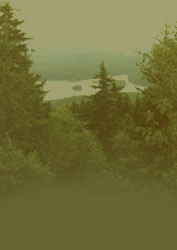|
Do you have something
happening in your corner of Washington? - Please call a member
or e-mail your observations to have them included here
December 2006:
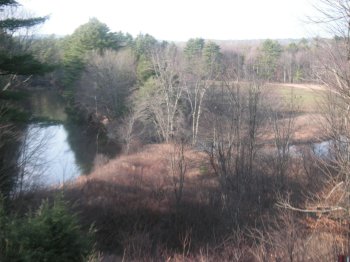
We have had no snow and
lots of warmth so far this month.
Nan found some good information on the NOAA website about
this strange winter weather.
This year through November, the temperatures in New Hampshire
were the 2nd warmest on record, with the month of November
ranking as the warmest month on record. New Hampshire experienced
the 2nd wettest period on record with New England as a whole
experiencing the wettest June - November.
Globally
the annual temperature for combined land and ocean surfaces
is expected to be sixth warmest on record for 2006. Some of
the largest and most widespread warm anomalies occurred in
southern Asia and North America. Canada experienced its warmest
winter and warmest spring since its national records began
in 1948.
Including 2006, six of the seven warmest years on
record have occurred since 2001 and the ten warmest years
have occurred since 1995. The global average surface temperature
has risen between 0.6°C and 0.7°C since the start of the 20th
Century, and the rate of increase since 1976 has been approximately
three times faster than the century-scale trend.
The extent
of Arctic sea ice was second lowest on record in September,
when annual sea ice extent is at its lowest point of the year.
This was only slightly higher than the record low extent measured
in 2005. According to the National Snow and Ice Data Center,
this is part of a continuing trend in end-of-summer Arctic
sea ice extent reductions of approximately eight percent per
decade since 1979, when recordkeeping began.
El Nino conditions
developed in September, and by the end of November, sea surface
temperatures in most of the central and eastern equatorial
Pacific were more than 1.8°F (1°C) above average. This El
Nino event is likely to persist through May 2007, according
to NOAA's Climate Prediction Center.
All information was found
at: NOAA National Climate Research
and:NOAA 2006 Climate Research
Here is also a great article to read about
the warm winter weather and it's confusing effect on wildlife:
Seacoast Online News
November:
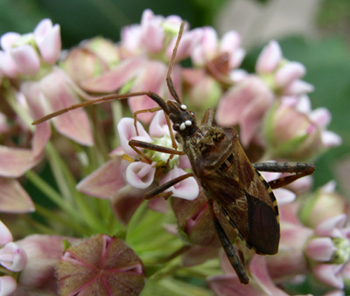
Mark commented on seeing large numbers
of Stink Bugs lately and wondered why there
are so many. Is it a Stink Bug Invasion?
This is one bug that knows how to get your attention. It is
noisy in flight, relatively large, conspicuously colored,
and releases a pungent odor when handled. If you have a home
in an area with coniferous trees, at one time or another you
have probably had a run-in with this creature.
People commonly refer to this insect as a “stink bug.” Although
it does have an odor, “stink bug” is not its true name. Its
technical name is Western Conifer Seed Bug (Leptoglossus occidentalis).
The Western Conifer Seed Bug (WCSB) is an intimidating-looking
insect that moves into homes in late fall to take shelter.
Although it does not bite or sting, as a member of the stink
bug family, it often releases an offensive odor when handled
— part of the insect’s defensive strategy. In flight, the
adults make a buzzing sound like a bumblebee.
In spring the bugs move back outdoors to nearby coniferous
trees to feed on the developing seeds and early flowers, using
their piercing-sucking mouthparts to pierce the scales of
conifer seeds and suck out the seed pulp. The list of host
plants includes white pine, red pine, Scotch pine, Austrian
pine, Mugho pine, white spruce, Douglas fir and hemlock. Because
these species commonly appear in home landscapes, the bugs
may take shelter for the winter in nearby homes and other
buildings.
In the spring females lay rows of eggs on needles of the host
trees. The eggs hatch in about ten days and the young nymphs
then begin to feed on tender cone scales and sometimes the
needles. Nymphs pass through five stages and reach adulthood
by late August. Adults then feed on ripening seeds until cold
weather arrives and the insects begin seeking overwintering
quarters.
If these seed bugs are a problem in your area, be sure to
screen attic or wall vents, chimneys and fireplaces so you
block their points of entry. Eliminate or caulk gaps around
door and window frames and soffits, and tighten up loose-fitting
screens, windows or doors to prevent these insects from getting
into your home. New Hampshire currently has no pesticides
specifically registered for control of WCSB. If large numbers
of these insects do invade your home, vacuum or sweep them
up and put them back outside. Information found at the
UNH Extension website
October:
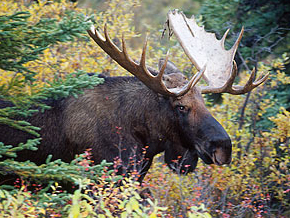
This month there have been lots of
mushrooms and moose to observe.
Since we have talked in the past about the mushrooms found
in Washington, here is some information about moose.
Moose are big. An adult moose, averaging
1000 pounds and standing 6 feet at the shoulder, is the largest
wild animal in North America. Moose have keen senses of smell
and hearing, but they're also near-sighted. Their front legs
are longer than their hind legs, allowing them to jump over
fallen trees, slash, and other debris. Moose, like deer, lack
a set of upper incisors; they strip off browse and bark rather
than snipping it neatly. Bulls and cows have different coloration
patterns. Bulls have a dark brown or black muzzle, while the
cows face is light brown. Cows also have a white patch of
fur just beneath their tail.
Only bulls grow antlers. Antler growth begins in March or
April and is completed by August or September when the velvet
is shed. Antlers are dropped starting in December; young bulls
may retain their antlers into early spring. Yearlings develop
a spike or fork; adults develop antlers that may weigh up
to 60 pounds with wide sweeping palms with many long tines.
The bell (the flap of skin and long hair that hangs from the
throat) is more pronounced in adult bulls than in cows or
immature bulls.
Today there are some 6,500 moose in New Hampshire, occurring
in all ten counties with highest densities in the Great North
Woods. During a year moose home ranges vary from 5 square
miles to more than 50 depending on the season.
Each year nearly 200 moose are killed on our highways. Their
dark coloration blends well with dark pavement. To avoid collisions,
drive slow enough at night and dusk so you can stop within
the limits of your headlights illumination.This information
was found at the NH state web site, to learn more about moose
click here:
NH State Moose information
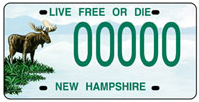
One way to support conservation and cultural
heritage in New Hampshire is by purchasing a conservation
license plate, also known as a Moose Plate.
Revenues generated are distributed to help fund projects that
focus on the protection of our state's critical resources.
The voluntary public purchase of the plates helps to ensure
that the scenic beauty, wildlife, and historic sites of New
Hampshire will be here for our children and grandchildren.
To find out more about Moose Plates click here:NH
Moose Plates
August :
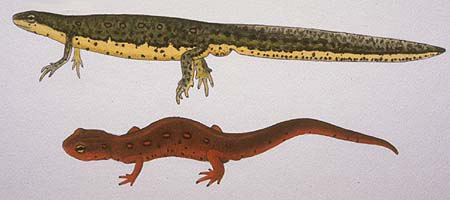
Michael Pon from Washington wrote a commentary
last week in the local paper "The Villager". He
was lamenting about the recent disappearance of Red
Spotted Newts from Millen Pond and what factors may
haves caused their decline in numbers. To read his commentary
click here:The
Villager article
We wrote about these wonderful creatures
in August 2005, here is the link to learn more about them:
2005
New in Nature Archives We hope they haven't
disappeared for good! They are a favorite creature to "catch
and release" for a lot of kids in town.
Don mentioned noticing lots of local Ash trees
with die back lately. He wondered if the damage could be caused
by a recently imported foreign pest called the Emerald Ash
Borer. First found in Detroit in the summer of 2002, this
insect has killed millions of ash trees in Michigan and has
since been discovered in parts of Ohio, Indiana, and Illinois.The
Emerald Ash Borer's primary movement seems to be through firewood,
so you should only use local sources and don't bring in firewood
from out of state. If the spread of Emerald Ash Borer is not
controlled, it could eliminate ash trees as a species from
North America. The foresters at the N.H. Division of Forests
and Lands are keeping an eye out for these pests and others
that threaten the trees in NH.
Ticks are plentiful this summer, as anyone
with a dog will attest. The New Hampshire Cooperative Extension
Service has lots of information for you on the varieties of
ticks found in this area and what to do if you find a tick
on you or your pet: NH
Cooperative Extension - Ticks
May :

Lots of wildflowers are
blooming: fringed polygala, star flower, goldthread, foam
flower, and rhodora is just starting to bloom. (Bradford
Bog will be spectacular soon)
April:
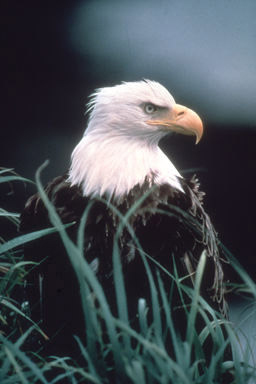
Two Bald Eagles were seen
on Half Moon Pond the week of April 10th, one mature and one
immature. A mature eagle was also spotted on the 14th. Everyone
should keep an eye out for these magnificent birds.
The Bald Eagle, Haliaeetus leucocephalus, is a magnificent
bird of prey that is native to North America. This majestic
eagle is not really bald; white feathers cover its head. The
derivation of the name "bald" is from an olde English word
meaning white. Bald eagles have a long, downward-curving yellow
bill, and large, keen eyes. These strong fliers have white
feathers on their head, tail, and wing tips; the body has
brown feathers. They can fly 20 to 40 mph in normal flight
and can dive at speeds over 100 mph. Adult eagles have a 7
ft wingspan and the females are 30% larger than the males.
They live and nest near coastlines, rivers, lakes, wet prairies,
and coastal pine lands in North America from Alaska and Canada
south into Florida and Baja, California. Bald eagles build
an enormous nest from twigs and leaves and may use the same
nest year after year, adding more twigs and branches each
time. The nest can be up to eight feet across and may weigh
a ton! Nests are located high from the ground, either in large
trees or on cliffs. A clutch of 1 to 3 eggs eggs is laid by
the female in the nest and both males and females incubate
the eggs. They both feed the hatchlings until they learn to
fly (fledge).
Eagles are carnivores (meat-eaters) and hunt during the day.
Their feet have knife-like talons which they use to catch
their prey. They eat mostly fish swimming close to the water's
surface, small mammals, waterfowl, wading birds, snakes, and
dead animal matter (carrion). By eating carrion they help
with nature's clean-up process and by hunting they help keep
animal populations strong. Bald eagles can actually swim!
They use an overhand movement of the wings that is very much
like the butterfly stroke. Their life span is up to 30 years
in the wild.
The bald eagle has been the national symbol of the USA since
1782, so when it became threatened with extinction in the
1960s due to pesticide use, habitat loss, and other problems
created by humans, people took notice. For years the bald
eagle was listed as endangered under the Endangered Species
Act. Now the number of bald eagles has increased so much that
in June, 1994 the U.S. Fish and Wildlife Service proposed
that they be downgraded from endangered status to the less
urgent status of threatened in all but three of the lower
48 states. The success of the bald eagle is a tribute to the
Endangered Species Act and is an incentive for increased awareness
and conservation everywhere.
March:
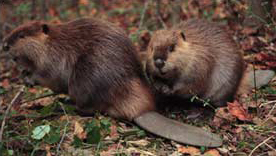
The
beaver (Castor canadensis) is the largest rodent in North America and can tip the scales at
more than 60 pounds, although an average adult weighs 3540
pounds. An adult beaver can be nearly three-feet tall when
standing on his hind legs.
Beavers typically live in lodges constructed from branches,
mud, and other debris, or in dens dug into the banks of streams
or lakes. Lodges may be created along the edges of canals
or ponds, or formed as mounded islands of interwoven branches
that stand further out in deeper water. The structures are
packed solid with mud to make them weatherproof—except for
the peak, which is left open for ventilation—and have at least
two or more water-accessible openings. In the fall, beavers
stockpile winter food supplies by sinking large amounts of
branches into the mud close by their lodges or dens. With
a sizable underwater cache, beavers can remain comfortably
well-fed even during the harshest winter freeze. They simply
swim beneath the water's icy surface to retrieve choice branches,
then devour them inside the lodge. For beavers, dam-building
is an instinctive survival skill. The main purpose is to surround
themselves with a stable body of water—understandably important
to animals who are far more adept in water than on land. The
resulting pond provides beavers with a safe refuge from predators;
flooding an even larger area also ensures watery access to
prime food sources in the vicinity.

Beaver lodge, food cache, and dam in water
All winter the beavers bring sticks from their underwater
cache into the feeding chamber of the lodge to gnaw the succulent
bark. They prefer trembling aspen, poplar, willow, and birch.
They also swim out under the ice and retrieve the thick roots
and stems of aquatic plants, such as pond lilies and cattails.
During mild winters and warm days in March and early April,
adult beavers emerge from their dull aquatic world to feed
on fresh woody stems along the shore. Beavers shift from a
woody diet to a herbaceous diet as new growth appears in the
spring. During summer, beavers will eat grasses, herbs, leaves
of woody plants, fruits, and aquatic plants.
Information found at:
Humane Society of the United States website
February:
 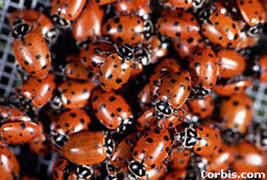
Lady beetles, often called Ladybugs or coccinellids,
are the most commonly known of all beneficial insects. In
Europe these beetles are called "ladybirds." There are nearly
5,000 different kinds of ladybugs worldwide, 400 of which
live in North America. The ladybug is the official state insect
of New Hampshire, Delaware, Massachusetts, Ohio, and Tennessee.
Both adults and larvae feed on many different soft-bodied
insects with aphids being a ladybug's favorite food. More
than 5,000 aphids may be eaten by a single adult ladybug in
its lifetime. Ladybugs chew from side to side and not up and
down like people do. If you squeeze a ladybug it will bite
you, but the bite won't hurt. A ladybug will play dead if
it is threatened. They also make a chemical that smells and
tastes terrible so that birds and other predators won't eat
them.
The male ladybug is usually smaller than the female. A female
ladybug will lay more than 1000 eggs in her lifetime and she
lays her eggs only where she knows there are aphids present.
Ladybugs usually do not have their spots for their first 24
hours of adulthood, so if you see one without spots, it may
be a brand new adult. The spots on a ladybug fade as the ladybug
gets older.
During the autumn, ladybugs crawl to over wintering sites
where a few to several hundred will gather in an aggregation.
They congregate in large numbers on the sunny side of the
house then they will enter the house through any small opening
to find a corner and hibernate. During hibernation, ladybugs
feed on their stored fat. If the humidity is ample in your
home, they will survive and fly away in the springtime. Ladybugs
won't fly until the temperature is above 55 degrees Fahrenheit.
These little creatures live for about a year. Some people
believe that if you find a ladybug in your house in the winter
you will have good luck.
Information found at: www.geocities.com/sseagraves/ladybugfacts.htm
To view yearly archives of our "New In
Nature" series click on year you wish to see.
2002
2003
2004
2005
2006
2007
2008
2009
2010
2011
2012
|


